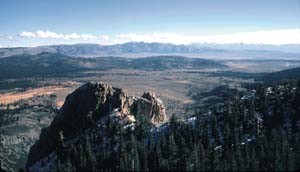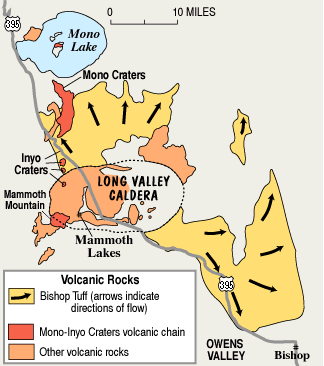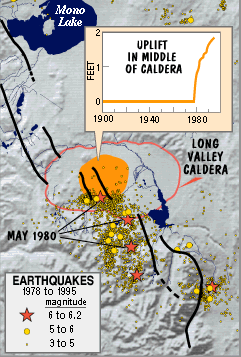

Living With a Restless Caldera - Long Valley, California
| Scientists have monitored geologic unrest in the Long Valley, California, area since 1980. In that year, following a swarm of strong earthquakes, they discovered that the central part of the Long Valley Caldera had begun actively rising. Unrest in the area persists today. The U.S. Geological Survey (USGS) continues to provide the public and civil authorities with current information on the volcano hazards at Long Valley and is prepared to give timely warnings of any impending eruption. |
In the 1850's, gold
fever brought the first waves of European settlers through the Long Valley
area of eastern California. Today, thousands of visitors are attracted
to the area year round by the spectacular mountain scenery of the eastern
Sierra Nevada. This landscape has been sculpted over the past 4 million
years by glaciers, earthquakes, and volcanic eruptions.

|
Long Valley Caldera in eastern California (here
viewed from its southwest rim toward its northeast
rim on the horizon 18 miles away) was formed about 760,000
years ago in a violent volcanic eruption that blew out
150 cubic miles of magma (molten rock) from beneath the
Earth's surface. U.S. Geological Survey scientists are
tracking continuing dome-like swelling centered
in the low forested hills in the middle of the
caldera. This swelling affects more than 100
square miles and is caused by magma rising beneath
the Earth's surface. (USGS photo by Roy Bailey)
|
About 760,000 years
ago a cataclysmic volcanic eruption in the area blew out 150 cubic miles
of magma (molten rock) from a depth of about 4 miles beneath the EarthÕs
surface. Rapidly moving flows of glowing hot ash (pyroclastic flows)
covered much of east-central California, and airborne ash fell as far
east as Nebraska. The EarthÕs surface sank more than 1 mile into the
space once occupied by the erupted magma, forming a large volcanic depression
that geologists call a caldera.

|

|
|
Much of the Long Valley area of eastern
California is covered by rocks formed during
volcanic eruptions in the past 2 million years. A cataclysmic
eruption 760,000 years ago formed Long Valley Caldera
and ejected flows of hot glowing ash(pyroclastic flows),
which cooled to form the Bishop Tuff. Wind-blown ash
from that ancient eruptionówhich was more than 2,000
times larger than the 1980 eruption of Mt. St.
Helens, Washington, that killed 57 people and
caused several billion dollars in damage&emdash;covered
much of the Western United States. The photo shows a volcanic
cone (Panum Dome) formed by eruptions about 600
years ago at the north end of the Mono Craters.
The most recent volcanic eruptions in the area
occurred in Mono Lake sometime between the mid-1700's
and mid-1800's.
|
Today, Long Valley occupies the eastern half of this 10-mile-wide, 20-mile-long caldera. Magma still underlies the caldera and heats underground water. The heated water feeds local hot springs and natural steam vents and drives three geothermal power plants, producing a combined 40 megawatts of electricity.
The Long Valley Caldera is only one part of a large volcanic system in eastern California that also includes the Mono-Inyo Craters volcanic chain. This chain extends from Mammoth Mountain at the southwest rim of the caldera northward 25 miles to Mono Lake. Eruptions along this chain began 400,000 years ago, and Mammoth Mountain itself was formed by a series of eruptions ending 50,000 years ago. The volcanic system is still active. Scientists have determined that eruptions occurred in both the Inyo Craters and Mono Craters parts of the volcanic chain as recently as 600 years ago and that small eruptions occurred in Mono Lake sometime between the mid-1700's and mid-1800's.
Although no volcanic eruptions are known to have occurred in eastern California since those in Mono Lake, earthquakes occur frequently. These earthquakes are caused by movement along faults and by the pressure of magma rising beneath the Earth's surface, two closely related geologic processes. In 1872, the magnitude 7.6 Owens Valley earthquake was felt throughout most of California, and a number of moderate (magnitude 5 to 6) earthquakes have shaken the Long Valley area during this century.
A period of ongoing
geologic unrest in the Long Valley area began in 1978, when a magnitude
5.4 earthquake struck 6 miles southeast of the caldera. This temblor
ended two decades of low quake activity in eastern California. The area
has since experienced numerous swarms of earthquakes, especially in the
southern part of the caldera and the adjacent Sierra Nevada.

|
Earthquake activity in the Long Valley area of
eastern California increased greatly after 1978. This
volcanically active area is located along the major faults
(black lines) that form the eastern edge of the Sierra
Nevada. The quake activity is caused by two closely related
geologic processesómovement along faults
and the pressure of magma (molten rock) rising
beneath the Earth's surface. Following four strong
magnitude 6 shocks in May 1980, the U.S. Geological Survey
(USGS) detected dome-like swelling in the middle of Long
Valley Caldera (inset graph). In response to these signs
of renewed volcanic unrest, USGS scientists
intensified their monitoring of the Long Valley
area.
|
The most intense of these swarms began in May 1980 and included four strong magnitude 6 shocks, three of which struck on the same day. Immediately following these shocks, scientists from the U.S. Geological Survey (USGS) began a reexamination of the Long Valley area and detected other evidence of unrestóa dome-like uplift in the caldera. Their measurements showed that the center of the caldera had risen almost a foot since the summer of 1979, after decades of stability. This continuing swelling, which by early 2000 totaled nearly 2.5 feet and affects more than 100 square miles, is caused by new magma rising beneath the caldera.
In response to this
escalating geologic unrest, the USGS intensified its monitoring program
in the Long Valley Caldera and Mono-Inyo Craters volcanic system. An
expanded network of seismometers installed in 1982 closely monitors earthquake
activity in the area, and other instruments track the continuing
swelling in the caldera. Data from these instruments help scientists
to assess the volcano hazards in the Long Valley area and to recognize
the early signs of possible eruptions. In cooperation with the California
Office of Emergency Services and civil authorities in eastern California,
the USGS has established procedures to promptly alert the public
to a possible eruption.
During the early 1990's, trees began dying off at several places on Mammoth Mountain on the southwest edge of Long Valley Caldera. Studies conducted by USGS and U.S. Forest Service scientists show that the trees are being killed by large amounts of carbon dioxide (CO2) gas seeping up through the soil from magma deep beneath Mammoth Mountain. Such emissions of volcanic gas, as well as earthquake swarms and ground swelling, commonly precede volcanic eruptions. When these events precede an eruption of a "central vent" volcano, such as Mount St. Helens, Washington, they normally last only a few weeks or months. However, such symptoms of volcanic unrest may persist for decades or even centuries at large calderas, such as Long Valley Caldera. Recent studies indicate that only about one in six such episodes of unrest at large calderas worldwide actually culminates in an eruption.
Over the past 4,000 years, small to moderate eruptions have occurred somewhere along the Mono-Inyo volcanic chain every few hundred years, and the possibility remains that geologic unrest in the Long Valley area could take only weeks to escalate to an eruption. Nonetheless, geologists think that the chances of an eruption in the area in any given year are quite small. To provide reliable and timely warning prior to an eruption, scientists of the USGS Volcano Hazards Program continue to closely monitor geologic unrest in the Long Valley area of eastern California and in other volcanic regions of the United States, including Hawaii, the Pacific Northwest, Wyoming, and Alaska. This ongoing work helps to better protect peoples lives and property from volcano hazards.
David P. Hill, Roy A. Bailey, Michael L. Sorey, James W. Hendley II, and Peter H. Stauffer
For more information
or to obtain paper copies of this fact sheet contact:
Earthquake
Information Hotline (650) 329-4085
U.S.
Geological Survey, Mail Stop 977
345
Middlefield Road, Menlo Park, CA 94025
COOPERATING
ORGANIZATIONS
California
Office of Emergency Services
California
Division of Mines and Geology
Inyo
County, California
Mono
County, California
Town of
Mammoth Lakes
Mammoth
Mountain Ski Area
University
of Nevada, Reno
U.S.
Forest Service
Future Eruptions in California's Long Valley - Area What's Likely?
Invisible CO2 Gas Killing Trees at Mammoth Mountain, California
PDF Version of this
fact sheet
U.S. GEOLOGICAL SURVEY REDUCING THE RISK FROM VOLCANO
HAZARDS